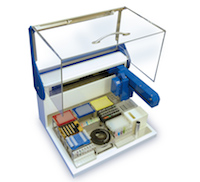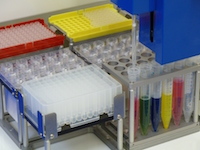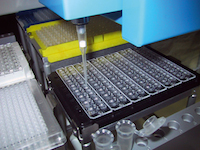By DORNIER LabTech…
PIRO® Personal Pipetting Robot
Dornier LTF’s PIRO® Personal Pipetting Robot provides a desktop-sized automated multiplate solution that can perform a wide range of liquid handling tasks from simple fluid transfers to highly complex reactions and analysis applications, such as normalization and serial dilutions.
PIRO® combines multi-dispensing functions with drag & drop programming, level sensing, multi-function plates and interchangeable heads, level sensing with clear tips, automatic tube switching and intelligent pipetting from database.
Design
The ultra compact PIRO® is based on a footprint equivalent to a larger desktop printer, incorporating a feature tree for a quick overview and change of layout and functions, a feature table for changing functions and programming from tables and menus, waste box for disposal of used tips and waste channel for transporting used tips to the outside of the enclosure.
Despite the compact layout, 16 deck positions are available with enough space for reagents, mixes and for 384 different samples to be set up without interrupting the run for adding tips. The operating interface mirrors the actual deck layout for operating simplicity and transparency with intuitive drag and drop programming.
PIRO® incorporates a liquid level sensor that is a sensitive electronic device relying on the detection of pressure changes to allow the robot automatically to detect when the pipetting tip is reaching the surface of the liquid. As soon as the tip reaches the liquid level surface, pressure is built up and is measured by the pressure sensor in the pipetting head, which then allows the pipetting head to lower the tip to a level aspirating the required volume. This ensures that a PIRO® run will not continue when liquid is missing, unless specified by the user, ensuring that all required volumes are transferred. If a vessel is empty, PIRO® will ask for confirmation to continue or allow the user to add liquid to the system and continue the run without losing the tasks performed so far.

When picking up liquid, the level sensing feature will determine to enter the liquid only as deep as it is needed and will prevent any droplets on the outside of the tips to be transferred to the next tube. In addition, using pressure as a detection system allows for all liquids to be detected and pipetted and no difference is made if a solution is conductive or not.
The multiple language operating system comes with free software updates.
Functions
PIRO® supports the full range of research laboratory applications including normalization of samples, dilution series, imports and exports, intelligent pipetting from database, single operation 384-well qPCR and multi-dispensing, automatic tube switching and fluid transfer for mixes or reagents.
These functions are supported by automatic level sensing with clear tips, interchangeable heads and full control over availability of tip positions and a drag and drop programming interface that can be used to generate reactions automatically.
These features enable an advanced range of functions that include:
- Ability to place one or more diluents or reagents
- Placing and copying diluents or reagents to any deck position
- Creation and calculation of standards as dilution series with dynamical variation
- Incorporating off-the-shelf or customized mixes within a single run
- Variation of sample rack and tube types
- Programmed variation of sample numbers and positions across multiple mix runs
- Sample normalization
- Serial dilutions
- Rearranging plate formats
- Cherry picking from various plates and formats
- Plate duplications
Benefits
The PIRO® Liquid Handling System offers an impressive range of user benefits combined with a full traceability of all pipetting steps. So a PIRO® gives you the upmost achievable security and control over your pipetting tasks.

Versatility
The PIRO® provides a versatile pipetting platform with many options for the end user.
A large variety of racks, plates, and tubes are available starting from 0.1 ml to 50 ml tubes with a tube depth of up to 100 mm. Combined with the ability to use 50 μl, 200 μl, or 1000 μl tips, this means PIRO® can provide sample pipetting up to 50 ml.
PIRO® can use deep-well plates, reservoirs, and passive cooling blocks as well as unusual plate formats like the Rotor-Gene, SmartCycler, Eco, LightCycler and others for various real time PCR platforms. Plates and tubes can be selected from the PIRO® database included in the software.

Precision
The PIRO® Liquid Handling System provides high precision in the x-, y-, and z-axis positions, with its stepper motors allowing for increments of 0.0065 mm enabling ultra-accurate pipetting for all plates and tubes.
PIRO®’s accurate positioning provides maximum quality pipetting performance even below 1 μl and also allows small liquid volumes to be placed on the wall of a tube, allowing the user to exactly determine where to dispense the liquid.
Coefficients of variation (CV) range from under one per cent in the 5 – 180 μl range to less than six per cent in the 1 – 2 μl range.
| Volume | Mean | S.D. | CV |
|---|---|---|---|
| 1 μl | 1.08 mg | 0.05 mg | 5.65% |
| 2 μl | 2.06 mg | 0.02 mg | 2.00% |
| 5 μl | 5.12 mg | 0.03 mg | 0.58% |
| 10 μl | 10.11 mg | 0.02 mg | 0.22% |
| 20 μl | 20.07 mg | 0.03 mg | 0.17% |
| 50 μl | 50.10 mg | 0.06 mg | 0.10% |
| 100 μl | 100.04 mg | 0.06 mg | 0.06% |
| 150 μl | 150.10 mg | 0.10 mg | 0.06% |
| 180 μl | 180.30 mg | 0.12 mg | 0.07% |
Reproducibility
PIRO® can support any polymerase chain reaction (PCR) or real-time/quantitative PCR (qPCR) setup.
With the PIRO® system, automation of any assay setup will guarantee reproducible results, including large numbers of repetitive assays, complicated setups including various mixes, several dilution series in the same run, or normalizations of DNA/RNA samples.
Fewer repeats will be needed due to accurate pipetting and human errors can be excluded.
Efficiency
The PIRO® supports a variety of smart functions, with various functions assignable to a single plate. Its deck positions are also interchangeable allowing related racks to be placed adjacent, resulting in shorter pipetting arm travel and decreased running times.
The user can pre-specify waste handling, deciding prior to run whether waste should stay inside the enclosure or be discarded to the outside.
While running, the PIRO® visually signals its current status; pausing, level sensing, interruptions, pipetting, or UV-sterilization procedure, to keep users informed of progress at a glance.
Pipetting speed can be changed to suit different liquid viscosities, with various mixing options available.
PIRO®’s multi-dispensing functions allow overall speed of any assay setup to be improved dramatically.
Convenience
The software of the PIRO® is easy to program, with no specialist training required. Any operation, ranging from simple liquid transfers to highly complex applications can be programmed within minutes.
The PIRO® works with comprehensive data logging for all steps in each pipetting project. Any programming step as well as every movement will be recorded and presented in the pre-run report.
The comprehensive post-run report includes all data on samples, pipetted volumes, pipetting steps, and recorded exceptions like run interruptions by the user. Results can be exported in various file formats including .csv files to be used in downstream applications. PIRO® can also import .csv files allowing the system to run setups created elsewhere.
PIRO® software can be used in many languages and is developed as an open system supporting integration with other laboratory systems.
Economy
The PIRO® reuses tips where possible (e.g. when the same liquid is used several times) and also has multi-dispensing functions that eliminate need for additional tips. The system’s high precision means fewer repeats due to pipetting errors while the graphical “What you see is what you get” operating interface reduces risk of confusion over placement of samples.
Only required standards created need to be used, resulting in fewer reactions to be done. As the liquid level sensing is working with pressure, clear tips can be used and no conductive tips are needed.
In all these ways, PIRO® saves cost in the laboratory and also helps to save time with its sophisticated multi-dispensing modes and by allowing direct import and export of data. Optional barcode reader for sample or plate details and pre-saved templates to start a run quickly will also reduce running times.
Safety and security
The PIRO® Liquid Handling System provides many features for a safe pipetting performance.
- The hood interlock sensors ensure the instrument pauses immediately when opening the hood during a run.
- Any mid-run manipulation will be recorded.
- The newly designed liquid level sensing system uses non-conductive tips and also monitors the amount of liquid in each tube during all steps in real time in the protocol. The system additionally detects the absence of tubes as well as not opened tubes and plates.
- The PIRO® tip detection system ensures a tip is attached to each pipetting head. If no tip is presented in the tip rack, the pipetting head moves to the next position until it finds a tip to continue the run, ensuring the run is never interrupted.
- The PIRO® system is set up to prevent any possible contamination risk and follows strict defined rules to avoid any cross contamination. Every liquid aspiration is followed by an intake of an air cushion before the transport to the target vessel continues.
- PIRO®’s software and level-sensing function combine to allow the system to be used plate independently, with the user enabled to determine how often a reaction should be performed. If PIRO® detects a missing liquid, this will be recorded in the post-run report.
Specifications
| Options and Expansion | |
|---|---|
| HEPA-Filter | High Efficiency Particulate Air filter system provides positive pressure |
| UV sterilization | UV light system for deck sterilization under closed lid conditions |
| Barcode reader | Auto import data from sample or plate |
| Pre-saved templates | Ability to start a run more quickly for reduced overall running times |
| Dimensions (W x D x H) | 600 x 515 x 470 mm |
| Precision, Accuracy | CV < 1 %, 5 μl – 180 μl (dry-well transfer), CV < 5 %, 2 μl – 5 μl (wet-well transfer), CV < 10 %, 1 μl – 2 μl (wet-well transfer, or better) |
| Electrical | 100 – 250 VAC, 50 / 60 Hz, 60 Watts |
| Weight | 45 kg |
| Relative Humidity | 40 – 70% |
| Communication | USB |
| Recommended computer requirements | Windows 7, Intel core 3.2 GHz |
| Pipetting volume range | 1 μl – 180 μl (180µl pipetting head) 5µl – 1000µl (1000µl pipetting head) |
| X-, Y-, Z-axis drive resolution | 0.0065 mm |
| Tip disposal | Selectable external or internal ejection of used tips |
| Pipetting speed | 10 μl – 200 μl / sec, software adjustable |
| Temperature range | 4 °C – 35 °C |
Resources
Click on Dornier LTF PIRO® Personal Pipetting Robot for more information.
Click on Dornier-LTF to contact the company directly.
Supplier Information
Supplier: DORNIER-LTF GmbH
Address: Rickenbacher Str. 107, 88131 Lindau, Germany
Tel: +49 8382 2730 890
Fax: +49 8282 2730 8929
Website: www.dornier-ltf.com















